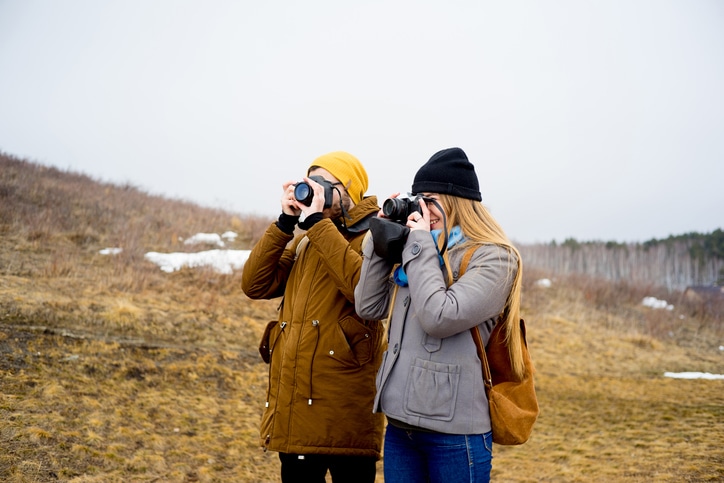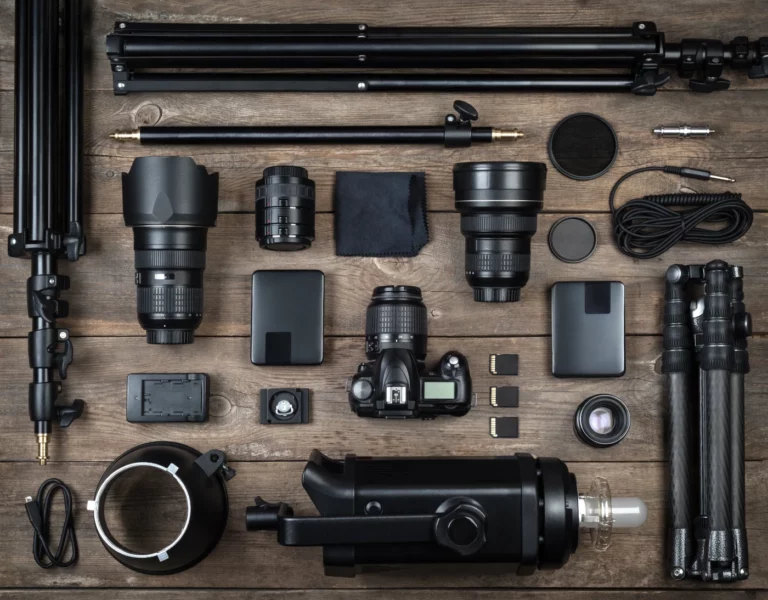You’ve dabbled back and forth with photography practically your whole life. You only saw it as a hobby, yet, when you hold a camera in your hands, everything just feels right with the world, and you get a sudden surge of inner peace.
However, doubt keeps knocking at your door — intrusive thoughts about being inexperienced, lacking tech-savvy skills, and flashbacks of dropping out of art school to take a desk job or get into a trade keep your camera on the shelf gathering dust and cobwebs.
We’re here to tell you to dust off that camera because you can become a professional photographer.
Carrie Fisher — the Princess Leia actress from Star Wars — once said, “Stay afraid, but do it anyway…just do it, and eventually, the confidence will follow.”
With that in mind, here are 11 tips on how to become a professional photographer, even if you’re scared.
Follow These 11 Tips (Or Don’t Call Yourself a Professional Photographer)
Keep in mind that these steps aren’t one-and-done. Some you have to practice and live them like a mantra. Skilled musicians don’t practice reading notes and songs once and then call themselves professionals. They keep practicing until it becomes second nature for them to play music.
You, too, can practice, and one day, you won’t call these items tips. You’ll call them instincts.
1. Toss Out the Doubts and Imposter Syndrome
It’s easy to fall into the trap of doubt and imposter syndrome, especially when you’re just starting. We get it. There are several ways to overcome imposter syndrome, such as:
- Having a positive mindset
- Celebrating your wins (even the small ones)
- Being mindful when scrolling through social media posts
Don’t let doubt and imposter syndrome stop you from achieving your dreams of becoming a professional photographer (or anything else positive, for that matter).
2. Zoom In On Your Areas of Interest

Think about photography like a large lake full of different fish types. There are so many different niches to choose from that it can be overwhelming. Here are some photography interests to try, including:
- Food: Food photographers capture photos of food in restaurants, caterer companies, and other culinary businesses.
- Wedding: Wedding photographers work with numerous couples and lean into the latest wedding photography trends. Into videography? Check out these wedding videography ideas.
- Real estate: Real estate photographers work with home sellers, real estate agents, home builders, and commercial companies to shoot the ins and outs of houses, apartments, office buildings, warehouses, and more.
- Landscape: Landscape photographers focus on nature and natural scenery like hills, mountains, bodies of water, trees, and more.
- Wildlife: Wildlife photographers shoot different types of animals worldwide, including lions, tigers, birds, exotic insects, and more.
- Photojournalism: Photojournalists work for newspapers, magazines, and other publications to capture candid events such as elections, protests, court cases, festivals, wars, and more.
- Sports: Sports photographers get close-up shots of athletes for local, national, and international leagues, depending on their clients’ needs.
- Fashion: Fashion photographers shoot different fashion shows and runway events around the world. They work with various designers, models, and stylists.
These are just a few of the different photography niches you could build your career on.
3. Invest in the Right Cameras and Equipment
Let’s talk camera equipment — specifically, camera types and additional gear you may need while on your photography journeys.
Digital Cameras
Digital cameras require you to learn different camera settings, such as aperture, shutter speed, ISO, flashes, modes, and more. Most digital cameras have LCD screens that give you a better view of your subject instead of relying solely on the tiny viewfinder.
If you’re just starting out in your photography career and aren’t sure what gear you need, check out our recommended beginner photography equipment and get tips from real photographers!
Smartphones
Smartphones have come a long way, baby. If you want to work as a photojournalist or freelance with the media, having a smartphone with a great camera and mobile phone editing app is a must. It can make or break your chance to have your work featured in a breaking news or public interest type of story.
Disposable Cameras
Disposable Cameras are lighter vs. other counterparts and, as the name implies, are meant to be thrown away after use. They take film or APS cartridges to protect the film from dust, fingerprints, and more.
Traditional Film Cameras
Traditional film cameras can give your photos a crisp and nostalgic look. You can go all new or shop for vintage film cameras on sites like eBay, Lomography, or in local antique shops.
Note: If you’re working with any type of film camera, you’ll need to know how to use a darkroom or find a local store that develops film.
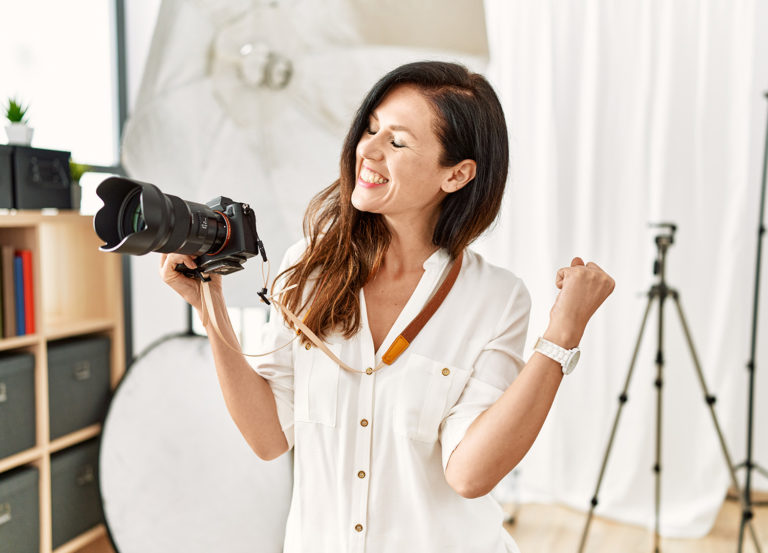
Polaroids
Polaroids lean into nostalgia and instant gratification. Each time you shoot a subject, it automatically prints the photo right away in black and white or color, depending on the film you preloaded into the camera.
Some Polaroid models look different from the traditional boxy designs. They come in numerous colors and (unlike their 1970’s predecessors) have different photo effect settings.
Claudia Hoag, professional headshot and business portrait photographer, described how to get great at capturing moments no matter what type of camera you choose.
“They say the best camera is the camera you have. It’s because the most important part of the camera is the photographer behind it. Learn, be curious, and photograph often. You’ll be on your way to great work.”
Other Must-Have Equipment to Become a Professional Photographer
Here are some other equally crucial must-have photography equipment most professionals will need:
- Tripods: A three-legged stand to hold your camera in place for stability, wide shots, or when you need to use a timer (e.g., to give you time to get into the photo)
- Filters: Gives finished portraits a new look depending on the filter’s intended effects
- Zoom and standard lenses: Lenses you can attach or detach if you photograph from short or long distances
- Flashes: Flashes add extra light to your subjects — ideal for shooting in a low-lit room or outdoors at night
- Camera bags: Bags or backpacks explicitly designed for holding camera bodies, lenses, and more
- Memory cards and cardholders: Cardholders are great for holding and organizing numerous memory cards in one place so you don’t lose them
- Rechargeable or extra batteries: No batteries means your camera can’t function properly — so make sure yours are charged and bring extras if you need them
4. Protect Your New Career and Gear With Insurance
You’ve already invested a ton of time and considerable money in your pursuit of becoming a professional photographer, so make sure you protect it properly. Insurance can protect you from paying for hefty claims out of pocket, such as:
- Someone suing you for invasion of privacy after finding you used their photo to market your business without their permission
- Your tripod scuffing the hardwood flooring at a venue and being sued to cover the cost of repairs
- Unhappy parents claiming you didn’t provide all the shots of their kids advertised in your special offer
- A bride requiring a trip to the ER after tripping over your tripod on the dance floor
For about what you’d pay for lunch at your favorite restaurant once a month, you can get photographers insurance that includes camera equipment insurance through Full Frame’s Annual+ policy.
It comes with:
- General liability insurance for third-party injuries or property damage
- Up to $5,000 per policy year ($1,000/item) of camera and gear coverage
- Personal and advertising injury for marketing mistakes and more
- Damage to rented premises (aka fire legal liability coverage)
- A medical expense limit to preclude the hassle of fairly inexpensive third-party injury-related claims, regardless of fault
- Products-completed operations to cover claims related to your products or services
You can also opt for more camera equipment coverage or extend the protection included in your Annual+ policy with “failure to deliver” coverage (also known as photographer professional liability or errors and omissions) or data breach coverage (cyber liability).
And no matter what FFI policy you buy, you can add additional insureds (a common requirement of venues) for a low fee.
5. Avoid Common Photography Mistakes
Becoming a professional photographer means avoiding rookie mistakes. Here are a few remedies to prevent common photography errors and pet peeves:
Take Off Lens Caps Before Shooting
You’re photographing like crazy and thinking you’re getting all these perfect snapshots. However, you see solid black backgrounds when you look at the photos on your memory card.
No, you’re not going blind, and there’s nothing wrong with your camera…except that you forgot to remove your lens cap.
Lens caps are supposed to protect the inside of lenses from getting dust, dirt, or other substances. But when you’re ready to capture images, take off the cap and put it somewhere safe, like your camera bag or pocket.
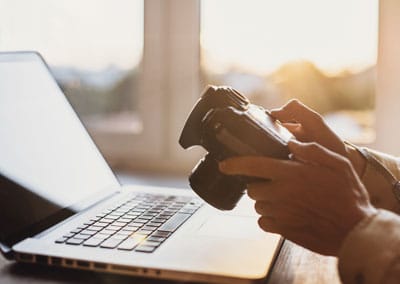
Secure Your Camera On Tripods
There’s no worse feeling in the world than having your camera slide off your tripod while trying to take a photo. You thought it was secure, but it wasn’t, and now you have to silently hope your camera or lens didn’t sustain damage from the fall.
Most camera bodies have holes that attach to tripods, but you have to rotate them on like a screwdriver tightening a screw. Remember: you rotate right to tighten and left to loosen.
Have Extra Memory Cards and Batteries On Hand
Sometimes, you may be photographing an event and have full or faulty memory cards. Having a cardholder with multiple memory cards allows you to keep filming all day and gives you the ability to quickly swap in a good card for a bad one.
Also, having extra batteries is essential. Sometimes, you’re filming and run out of battery life. Having extra charged batteries can help you to keep capturing moments worry-free.
Get Permission to Photograph in Specific Locations
You may be interested in photographing public events, snapping pics of wildlife in national parks, or capturing clicks on open mic performances in bars or nightclubs. However, if you’re not careful, these locations can have strict photographer rules.
Being a professional photographer means asking venue owners or event organizers or getting required permits beforehand. If you’re going to use the photos for commercial or press purposes (like for magazines, news websites, or to sell something), you may also want to have the subjects sign photo releases, and you may need to do additional paperwork as well.
You may think that’s unfair, but it’s nothing personal. Venues and events want to remain compliant with established rules. If you show up unannounced, you’re ruining your reputation and making the venue owners and event coordinators look bad.
Learn Your Camera Settings
Understand these three essential camera settings: aperture, shutter speed, and ISO. They all work together, and when they’re all in harmony, you get great photos no matter the location, time, or event.
Here’s a brief definition of each:
- Aperture: How wide a camera lens starts and how much light shines on your subject. Values range from f/1.4 (widest) to f/22 (the narrowest). The narrower the aperture, the better light and focus you’ll have on your subjects.
- International Organization for Standardization (ISO): Numbers (100 to 6400) that indicate a camera’s sensitivity to light. The lower the value, the more focused and less grain you’ll have in your photos.
- Shutter Speed: How long a camera’s shutter is open when photographing. Values from 2” to 1/2000 indicated how focused action shots will be. Higher shutter speeds of 1/1000 or 1/2000 means clear, crisp photos.
The more you know your camera settings, the easier it will get when taking photos. You’ll also avoid taking grainy, unfocused, or overexposed images that keep people from knowing what your subjects are. Taking test shots can also make things easier.

Be Patient With Subjects
Photography is a sociable industry. True, you are in the driver’s seat when telling subjects how to pose. But if you’re not patient or kind to your subjects, it can tarnish your reputation.
Remember to slow down, breathe, and relax. Yes, you’re in control, but take it easy. People will leave more excellent reviews and testimonials if you make them feel comfortable.
Watermark Your Photos
If your proofs aren’t watermarked, putting them online or sending them to clients is tantamount to giving them away. And you didn’t learn how to become a professional photographer just to give your work away for free!
As you grow your business, lightly watermark your photos so those who see them will know you and your photography business. You’ll also need to know how to do this when working with clients who will be choosing from proofs.
When editing or retouching photos, there are options that allow you to watermark and copyright your images with your name, business name, or logo. Place the watermark somewhere on the image where it’s hard to crop out, making it difficult for photo pirates to steal your image.
Sebastián Garrido Hernández, a photographer and digital marketing manager for Vibe Adventures, recalled not watermarking his photos before posting them on social media.
“When I was doing press photography for the Top Gun: Maverick Mexico City premiere, I took this amazing portrait of one of the actors. I uploaded it to Instagram later and tagged the actor. The next thing I knew, he uploaded the photo to his Instagram, and the photo went viral. All of a sudden, it [was] everywhere on the internet, and I never got a single mention or credit for my photo.”
6. Learn From the Experts
It’s unlikely that you’ll become great at your photo-artistry and business without learning from other masters of the craft.
Follow Pro Photogs on Instagram (and Other Social Media)
The great thing about social media is that you can follow and interact with almost anybody — including professional photographers. Following photographers in your niche (i.e., food, wedding, fashion, or photojournalism) allows you to review their portfolio and trade tips.
For example, you could follow a few photographers on Instagram — such as Paul Nicklen, Stacy Kranitz, or Linsay Adler — to see how they take their photos, build their followers, and make their posts relevant with relevant hashtags and keywords. Accounts like camera.setup even share hacks about how to get photos and videos like the pros.
Go to Conventions
Don’t focus solely on interacting with other photographers online. Join different photography associations and visit some local or national conferences or conventions. You never know what friends you’ll make or who you’ll meet. Plus, going to conventions can help grow and expand your professional network.
Some top photography conventions include:
Who knows? As you grow in your niche and portfolio, a conference board might see your images and ask you to speak at a future convention.
Find, Watch, and Subscribe to YouTube Videos
Find professional photographer videos on YouTube and learn from these experts. They can show you the ropes about camera settings, tripods, money-making secrets, and more. When you find photographers you like, you can subscribe to their channels to catch up on their latest videos.
7. Find a Mentor
Learning from a mentor in your niche, like Mike Wardynski for example, gives you a unique, personal experience on how to become a professional photographer. One you can’t get from books, articles, or YouTube videos. Good mentors are a fountain of knowledge and can open numerous doors for you in the industry.
Where to Find Photography Mentors
There are several places you can find photography mentors, such as:
- Colleges, workshops, or classes (in-person or online)
- Local photography clubs
- Online photography groups
- Professional photography associations
- Photography conventions

Ask to Assist, Shadow, or Second-Shoot
When contacting or speaking to a potential photography mentor, ask them if you can be their assistant. Think of this as a one-on-one internship or a personal apprenticeship. You’re humbling yourself by partnering with someone with years of industry knowledge and wisdom.
If you’re professional, patient, and open to learning, they can teach you specific photography and business skills.
Pick Their Brains (Not Literally, Of Course)
If your photography expert doesn’t need an assistant or protege, that’s ok. If they’re willing, try setting up a lunch date, phone call, or email conversation where you can query them about their experiences and pick their brain.
Ask all the right questions, and don’t leave any stones unturned. Repeat these steps with a few other photog masters. Persistence pays off.
Learn as Much as Possible
When you find a mentor who needs you as their assistant, soak up every minute of it like a sponge. Learn as much as possible.
8. Go to School (or Take Cool Online Courses)
Becoming a professional photographer doesn’t require a degree. Some successful photographer business owners are self-taught.
However, if you thrive in a classroom setting, take some classes at your local community college or university, photography institute, community center, or public library. You could also take online courses via Udemy, MasterClass, Skillshare, LinkedIn, and more.
9. Keep Networking Until Your Shutter Finger Falls Off
Shaking hands with other photographers and networking with people in the industry, like models, stylists, venue owners, event organizers, and more, builds your network AND offers word-of-mouth and referral opportunities to get more gigs.
In addition to joining local and well-known photography clubs and associations, join some Facebook and LinkedIn groups to share your work, learn new things, and “talk shop” with fellow Shutterbugs.
Here are a few groups to help you get started:
10. Continuously Build Your Portfolio
You must keep building your portfolio as you learn new skills and earn more gigs. The portfolio should align with your industry. For example, you wouldn’t submit a portfolio with sports or food images if you want to work in the wedding photography industry.
Your portfolio should focus on telling clear narratives with images with a beginning, middle, and end. Let’s say you’re a fashion photographer who follows a novice local fashion designer. Some of your photos should show the fashionista working late to make the perfect dresses for models on an old sewing machine.
The story progresses with the designer creating unique dresses, skirts, blouses, and other outfits. Then, you could photograph the designer working with models and what they look like as they try on the designer’s outfits.
Your “ending” of this story could showcase models walking down a catwalk at a fashion show wearing the designer’s clothes for others to see.
11. Launch Your Business and Market Yourself (Checklist)
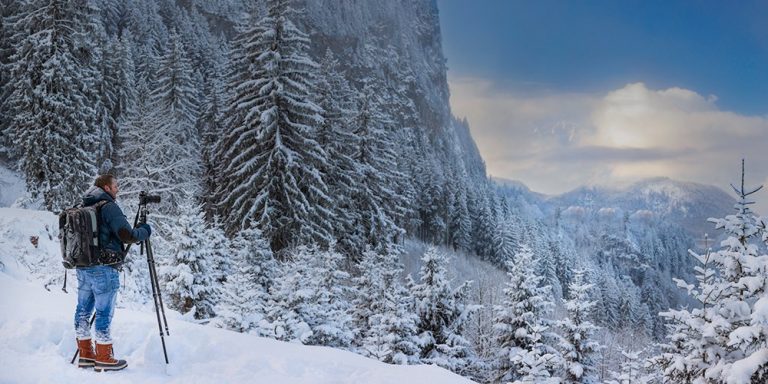
Getting clients, learning the ins and outs of photography, and networking is only half the fun. Wedding and portrait photographer Omotola Ajibade said it’s vital for photographers to be business and camera-savvy.
“Plenty of great photographers cannot sustain a career because they have poor business skills or don’t know what they need to do to get to the next level. Every niche of photography has its own business model, so it’s essential to learn what the best practices are for your niche before you start to experiment to create a business model that works for you.”
Here’s a quick checklist of how professional photographers should create and market their business for a sustainable future:
✅ Find a business name
✅ Register your business
✅ Lock down your photography liability insurance
✅ Build a website
✅ Use social media
✅ Give out posters, flyers, and business cards
You, too, can become a professional photographer if you learn and practice these techniques religiously.
Have More Questions About How To Become A Professional Photographer? We’re On It.
How Long Does It Take to Become a Professional Photographer?
Becoming a professional photographer doesn’t happen overnight. It takes time to invest in the right photography equipment, learn your camera settings, build a solid portfolio, and find the right mentor in your area of interest.
Is 30 Too Late to Become a Photographer?
No — 30 is not too late to become a professional photographer. You can get into photography at any age if you’re willing to learn, practice, and network with different photographers consistently to improve your skills.
Can You Call Yourself a Professional Photographer If You’re Self-Taught?
Absolutely! Many professional photographers took online or in-person classes, while others became completely self-taught by learning everything about their cameras, equipment, and niche. They found mentors to assist and work with to learn the secrets of the trade and get industry connections.

